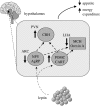Appetite and energy balance signals from adipocytes
- PMID: 16815801
- PMCID: PMC1642696
- DOI: 10.1098/rstb.2006.1859
Appetite and energy balance signals from adipocytes
Abstract
Interest in the biology of white adipose tissue has risen markedly with the recent surge in obesity and its associated disorders. The tissue is no longer viewed simply as a vehicle for lipid storage; instead, it is recognized as a major endocrine and secretory organ. White adipocytes release a multiplicity of protein hormones, signals and factors, termed adipokines, with an extensive range of physiological actions. Foremost among these various adipokines is the cytokine-like hormone, leptin, which is synthesized predominantly in white fat. Leptin plays a critical role in the control of appetite and energy balance, with mutations in the genes encoding the hormone or its receptor leading to profound obesity in both rodents and man. Leptin regulates appetite primarily through an interaction with hypothalamic neuroendocrine pathways, inhibiting orexigenic peptides such as neuropeptide Y and orexin A, and stimulating anorexigenic peptides such as proopiomelanocortin. White fat also secretes several putative appetite-related adipokines, which include interleukin-6 and adiponectin, but whether these are indeed significant signals in the regulation of food intake has not been established. Through leptin and the other adipokines it is evident that adipose tissue communicates extensively with other organs and plays a pervasive role in metabolic homeostasis.
Figures




References
-
- Ahima R.S, Prabakaran D, Mantzoros C, Qu D.Q, Lowell B, Maratos-Flier E, Flier J.S. Role of leptin in the neuroendocrine response to fasting. Nature. 1996;382:250–252. doi:10.1038/382250a0 - DOI - PubMed
-
- Ahima R.S, Saper C.B, Flier J.S, Elmquist J.K. Leptin regulation of neuroendocrine systems. Front. Neuroendocrinol. 2000;21:263–307. doi:10.1006/frne.2000.0197 - DOI - PubMed
-
- Arch J.R.S. Central regulation of energy balance: inputs, outputs and leptin resistance. Proc. Nutr. Soc. 2005;64:39–46. doi:10.1079/PNS2004407 - DOI - PubMed
-
- Arch J.R.S, Stock M.J, Trayhurn P. Leptin resistance in obese humans: does it exist and what does it mean? Int. J. Obes. 1998;22:1159–1163. doi:10.1038/sj/ijo/0800779 - DOI - PubMed
-
- Arita Y, et al. Paradoxical decrease of an adipose-specific protein, adiponectin, in obesity. Biochem. Biophys. Res. Commun. 1999;257:79–83. doi:10.1006/bbrc.1999.0255 - DOI - PubMed
Publication types
MeSH terms
LinkOut - more resources
Full Text Sources

